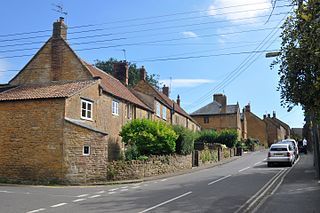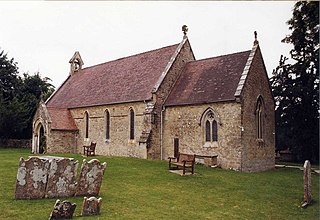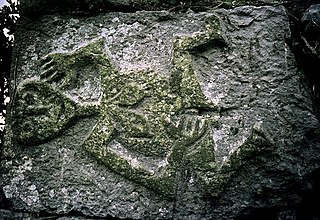
A sheela na gig is a figurative carving of a naked woman displaying an exaggerated vulva. These carvings, from the Middle Ages, are architectural grotesques found throughout most of Europe on cathedrals, castles, and other buildings.

Fethard is a small town in County Tipperary, Ireland. Dating to the Norman invasion of Ireland, the town's walls were first laid-out in the 13th century, with some sections of these defensive fortifications surviving today.

White Island is an island in Lower Lough Erne, County Fermanagh, Northern Ireland. It is situated in Castle Archdale Bay off the east shore of Lower Lough Erne. The ruins of an ancient church are found near the shore, built on the site of an earlier monastic settlement. It still has an intact arched Romanesque doorway. The Church and carved figures are State Care Historic Monuments sited in the townland of White Island, in Fermanagh and Omagh District Council area.

Barbara Freitag-Rouanet is a German-born Brazilianist, sociologist, author, and academic at Universidade de Brasília. Her family emigrated to Brazil in 1948 when she was 7.

Whittlesford is a village in Cambridgeshire, England, and also the name of an old hundred. The village is situated on the Granta branch of the River Cam, seven miles south of Cambridge. Whittlesford Parkway railway station serves the village.

Stoke-sub-Hamdon, also known as Stoke under Ham, is a large village and civil parish in the South Somerset district of Somerset, England. It is situated 5 miles (8 km) west of Yeovil, with which it is linked by the A3088 road. The parish is located near the River Parrett, and includes the village of East Stoke.

The Church of St Mary and St David is a Church of England parish church at Kilpeck in the English county of Herefordshire, about 5 miles from the border with Monmouthshire, Wales. Pevsner describes Kilpeck as "one of the most perfect Norman churches in England". Famous for its stone carvings, the church is a Grade I listed building.

Fiddington is a village and civil parish 2.5 miles (4 km) north-east of Nether Stowey, and 6 miles (10 km) north-west of Bridgwater in Somerset, England. The parish includes the hamlets of Bonson and Whitnell.

Holy Cross Church, Binstead is a parish church in the Church of England located in Binstead, Isle of Wight.
Kiltinan Castle is a castle near Fethard, County Tipperary, Ireland.
HMS Shelanagig, was a sloop of 16-guns purchased in the West Indies in 1780 for the Royal Navy. She was under the command of James Shepherd,, and her Second Lieutenant was Home Popham.

Roscommon County Museum is a museum dedicated to the history of County Roscommon, and is run by the County Roscommon Historical and Archaeological Society. The museum is housed in a former Presbyterian church in Roscommon town.

The Anglican Church of St Martin in Fiddington within the English county of Somerset dates from the 11th century and has been designated by English Heritage as a Grade II* listed building.

Clomantagh Castle is a 15th-century tower house located near Freshford, County Kilkenny, in Ireland. Originally constructed in the 1430s, additional buildings and outbuildings were added in the subsequent centuries - including a connected 19th century farmhouse. Carvings on the castle's walls include a Sheela na gig relief.

Castlemagner is a village, townland and civil parish in the Duhallow area of north-west County Cork, Ireland. Castlemagner is within the Cork North-West.

The Coolaghmore sheela na gig was discovered in 1975 at the 13th century church at Coolaghmore, County Kilkenny, Ireland during clearance work at the graveyard. It is thought to have been buried in the 19th century. According to local sources, it had been found in a well in Kyle previously and been brought to Coolaghmore Graveyard. It was then donated to Rothe House Museum via Kilkenny Archaeological Society where it is on display in a bricked up window in the shop of the first of the three houses since about 2012. The sites and monuments records number is KK019-026170.

The Liathmore Sheela-na-gig is a carving on the northern doorway at the larger church ruin at Liathmore monastic site in the townland of Leigh, County Tipperary in Ireland. The Sites and Monuments Record number for the sheela na gig carving is TN042-055004.

The Kiltinan Church sheela-na-gig is a carved depiction of a nude woman exposing her vulva which used to be part of Kiltinan Church ruin near Fethard, County Tipperary as a quoin stone in the Southwestern corner of the church. However, it was stolen in 1990 and has not been located since. Fethard Historical Society issued a Wanted poster to help with the retrieval. The National Sites and Monuments no. is TS070-101003.

The Church of Saint Nicholas is a Church of England parish church in Studland, Dorset, England. It was built in the early 12th century on the foundations of an earlier Anglo-Saxon church. It is recorded in the National Heritage List for England as a Grade I listed building, and is a good example of a small, largely unaltered, Norman church.

St Gobnait's well is a religious complex built on the site of a 6th or 7th century nunnery near Ballyvourney, County Cork, Ireland. Consisting of a holy well, two churches and a graveyard, it dates to the Middle Ages. The site is associated with the 8th century saint Gobnait, and today it is a place of veneration and pilgrimage, where people walk around the site reciting the rosary to pray for the dying and dead. Eleventh February and Whit Sunday are the two central dates of gathering.

















